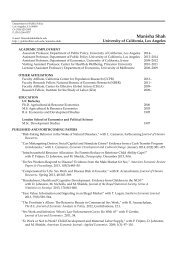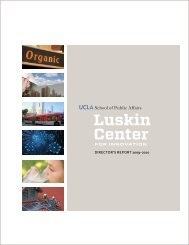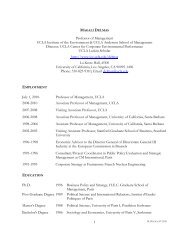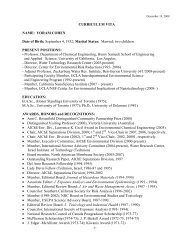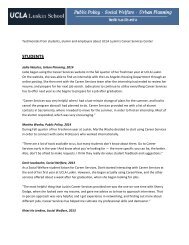Making a Market Executive Summary.pdf - UCLA Luskin School of ...
Making a Market Executive Summary.pdf - UCLA Luskin School of ...
Making a Market Executive Summary.pdf - UCLA Luskin School of ...
Create successful ePaper yourself
Turn your PDF publications into a flip-book with our unique Google optimized e-Paper software.
How much solar capacity can multi-family housing contribute and<br />
what incentives must we create to encourage solar development?<br />
Based on past studies, we know that one megawatt (MW) <strong>of</strong> solar capacity is roughly<br />
sufficient to <strong>of</strong>fset the energy needs <strong>of</strong> 100 homes. With that measurement in mind,<br />
we can look at the overall capacity that exists on ro<strong>of</strong>tops in Los Angeles. If it were<br />
technically and economically feasible to build solar panels on every available ro<strong>of</strong>top,<br />
the following totals could be generated:<br />
Commercial and Industrial:<br />
Single Family Homes:<br />
Multi-family Homes:<br />
Government/non-pr<strong>of</strong>it:<br />
TOTAL:<br />
2,218 MW<br />
1,752 MW<br />
1,411 MW<br />
156 MW<br />
5,537 MW<br />
It is important to note that these totals are strictly theoretical, as it is unlikely that solar<br />
panels will be installed on every Los Angeles ro<strong>of</strong>top in the near future. Yet they give a<br />
general sense <strong>of</strong> the total physical capacity for solar in the city. Roughly speaking, if<br />
every multi-family ro<strong>of</strong>top could be effectively covered with solar panels, they would<br />
have a capacity <strong>of</strong> 1.4 GW – sufficient to power 140,000 homes – or 8 percent <strong>of</strong> the<br />
city’s current energy needs.<br />
As it turns out, this capacity is spread throughout the city in a number <strong>of</strong> clusters <strong>of</strong><br />
great potential. As it turns out, there is physical potential <strong>of</strong> between 59 and 130 MW<br />
<strong>of</strong> solar on multi-family housing in each <strong>of</strong> the city’s 15 council districts. At least six <strong>of</strong><br />
these districts have capacities <strong>of</strong> between 75 and 100 MW, further indicating the even<br />
spread. The total number <strong>of</strong> multi-family sites is in excess <strong>of</strong> 100,000.<br />
So, which <strong>of</strong> these sites can most easily be developed? The first consideration is size<br />
and shape: large, flat ro<strong>of</strong>tops provide the most cost-effective solar power. Based on our<br />
analysis, the sites most ripe for development are those with a potential <strong>of</strong> 50 kW or more.<br />
There are approximately 4,000 buildings in the City <strong>of</strong> Los Angeles that fall into this<br />
category, with a potential capacity <strong>of</strong> more than 300 MW. Given the economies <strong>of</strong> scale<br />
and the number <strong>of</strong> large, flat ro<strong>of</strong>tops on multi-family buildings, this sector is likely to be the<br />
second most cost-effective market (after commercial and industrial) for solar in the city.<br />
In short, it will be easier and less expensive to harness significant quantities <strong>of</strong> solar<br />
power from multi-family ro<strong>of</strong>s than from single-family homes or smaller commercial<br />
ro<strong>of</strong>tops. Thus, it is a tremendous market that can bring very significant solar capacity<br />
to Los Angeles.<br />
6



